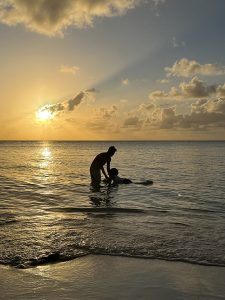Trivia, info, and other Father’s Day nuggets

Photo by Nhorleen Lilles
In honor of that special man in our lives who provides the template for who we eventually become in life, these nuggets of information show why they earn the moniker of superhero.
Historians describe Father’s Day as an event that complements Mother’s Day in celebrating fathers, fathering, and fatherhood. Observed in 111 countries worldwide, Father’s Day is celebrated every third week of June among several countries, including in the United States, Canada, the United Kingdom; Algeria and Kenya in Africa; Argentina and Colombia in South America; and in Japan, Singapore, and the Philippines in Asia. A host of other countries celebrate the occasion on different dates and depending on the country’s tradition.
Irish and Polish communities, as well as Spain and Portugal, join other Catholic countries in observing Father’s Day on March 19, which also falls on the Feast of St. Joseph. In Taiwan, Father’s Day is held on Aug. 8—the eighth day of the eighth month—as the Mandarin Chinese word for eight sounds like the word for “Papa.” Father’s Day in Thailand is celebrated on Dec. 5, which is the birthday of former King Bhumibol Adulyadej.
The earliest mention of a Father’s Day celebration dates to 1508 when it was considered as a Southern European tradition.
In modern history, particularly in the United States, Father’s Day finally being declared a U.S. national holiday only gained momentum in 1972, even though efforts to make the celebration official began in 1910,
Two women take the credit for getting Father’s Day recognized: Grace Golden Clayton and Sonora Smart Dodd. Clayton, the daughter of a devoted minister, organized the first known event dedicated to fathers on July 5, 1908, with a father-themed memorial honoring 360 men, most of whom were fathers, who died in the worst mining accident in U.S. history. This annual event, however, failed to gain momentum since it was only promoted within the confines of the West Virginia community.
Officially known to have placed Father’s Day on the calendar is Dodd who, with support from the Spokane Ministerial Association and the Young Men’s Christian Association, hosted a “father’s day” event honoring her father and other fathers as well. The event was originally scheduled to be held on June 5, which was the birthday of Dodd’s father. However, the date changed to June 19, 1910, and became an annual event from thereon. Soon after this, other towns began holding their own Father’s Day celebrations.
Despite widespread support, Father’s Day became an official, permanent public holiday just 51 years ago. President Woodrow Wilson in 1913 was the first among four U.S. Presidents who supported the passage of the first bill in the U.S. Congress commemorating Father’s Day. Congress initially resisted because they were worried about commercialization.
In 1921, President Calvin Coolidge signed a resolution in favor of Father’s Day “to establish more intimate relations between fathers and their children and to impress upon fathers the full measure of their obligations.” Then in 1966, President Lyndon Johnson signed an executive order designating the third Sunday in June the official day to observe Father’s Day. But it was only under President Richard Nixon when Congress passed an act officially making Father’s Day a national holiday.
According to historical accounts, the event failed to evoke the same sentiments of gratitude and thanks people feel for mothers on Mother’s Day. It is widely believed that sociological changes and attitude toward fatherhood were the reasons behind the delay in officially making Father’s Day a U.S. national holiday.
Historians further claim that a majority of the population did not warm up to the idea of commercializing the occasion with men receiving flowers and gifts, which eventually were often paid for by the father himself.
In American Fatherhood: A Cultural History by Lawrence R. Samuel, the author also stated that during the first half of the 20th century, families were patriarchal in nature, hence it was pointless to honor fathers when it was the mothers who were underappreciated.
Two economic events that also helped push forward the concept of Father’s Day were the Great Depression and World War II. Like Mother’s Day, it was the struggling store owners who used Father’s Day to make an extra buck with the sale of ties, clothes, and other goods that men needed. Father’s Day was also meant to support and show appreciation to American men and fathers who were in the front lines during World War II.
Did you know?
The modern drinking fountain was invented by Halsey Taylor in 1912 as a tribute to his father.
Neckties were mass-produced in the 1920s to keep up with the demand surrounding the unofficial Father’s Day holiday in the 1920’s.
Frank and Nancy Sinatra became the only father-daughter collaboration to hit the top spot on the Billboard charts with their hit single Something Stupid.
Former U.S. President John F. Kennedy was named “Father of the Year” in 1963, an award he received just several months before he was assassinated.
Former U.S. President Barack Obama has been named as the first of 12 doting dads in the United States, according to NBC News. The list includes Jim Henson, the inventor of The Muppets; Nicolas II, the last tsar of Russia; former U.S. president Abraham Lincoln; and the inventor, Charles Darwin.
Among the most prolific fathers in history are the Chinese warrior Genghis Khan, who has supposedly fathered thousands of children, while Ismail Ibn Sharif has had 888 Children. Bertold P. Wiesner. the operator of a fertility clinic, fathered 600 children, according to huffpost.com.
The National Retail Federation projects that consumers will spend a total of $22.9 billion this year to celebrate Father’s Day and that special outings, clothes, electronics and personal care are four of the top gifts consumers will be gifting fathers this 2023.























